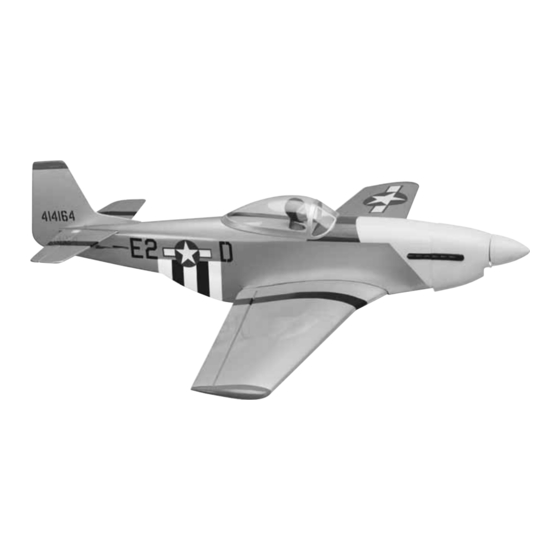GREAT PLANES COMBAT MUSTANG Combat P-51 ARF Buku Petunjuk - Halaman 14
Jelajahi secara online atau unduh pdf Buku Petunjuk untuk Mainan GREAT PLANES COMBAT MUSTANG Combat P-51 ARF. GREAT PLANES COMBAT MUSTANG Combat P-51 ARF 20 halaman.

3. Install an on/off switch in the fuselage following the
instructions that came with the switch.
Finishing Touches
1. Cut the canopy on the cut lines. Glue the canopy to the
fuselage. We find that R/C-56 canopy glue works well for this.
2. Cut the exhaust stacks as shown. Cut the set of six
exhaust stacks in half. One half is glued to the cowl and the
other is glued to the fuselage. Glue to both sides of the cowl
with R/C-56 canopy glue.
3. Use scissors or a sharp hobby knife to cut the decals
from the sheet.
4. Be certain the model is clean and free from oily
fingerprints and dust. Prepare a dishpan or small bucket with
a mixture of liquid dish soap and warm water–about one
teaspoon of soap per gallon of water. Submerse the decal in
the soap and water and peel off the paper backing. Note:
Even though the decals have a "sticky-back" and are not the
water transfer type, submersing them in soap & water allows
accurate positioning and reduces air bubbles underneath.
5. Position the decals on the model as seen on the box
cover. Holding the decal down, use a paper towel to wipe
most of the water away.
6. Working from the middle to the outside, use a piece of
soft balsa or something similar to squeegee remaining
water from under the decal. Apply the rest of the decals the
same way.
GET THE MODEL READY TO FLY
Check the Control Directions
1. Turn on the transmitter and receiver and center the
trims. If necessary, remove the servo arms from the servos
and reposition them so they are centered. Reinstall the
screws that hold on the servo arms.
2. With the transmitter and receiver still on, check all the
control surfaces to see if they are centered. If necessary, adjust
the clevises on the pushrods to center the control surfaces.
3. Make certain that the control surfaces and the carburetor
respond in the correct direction as shown in the diagram. If any
of the controls respond in the wrong direction, use the servo
reversing in the transmitter to reverse the servos connected to
those controls. Be certain the control surfaces have remained
centered. Adjust if necessary.
Set the Control Throws
Use a Great Planes AccuThrow (or a ruler) to accurately
measure and set the control throw of each control surface
as indicated in the chart that follows. If your radio does not
have dual rates, we recommend setting the throws at the
low rate setting.
14
